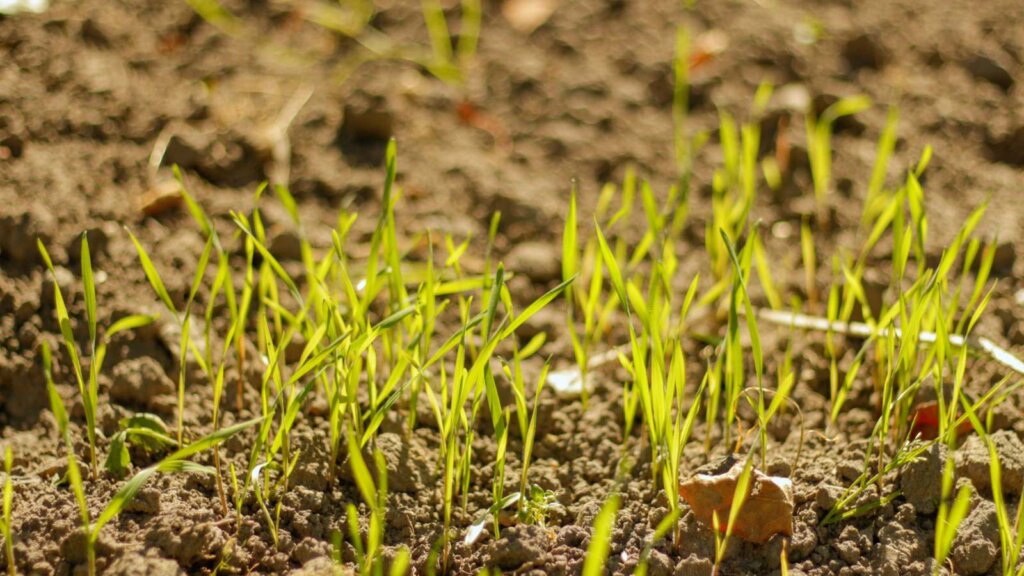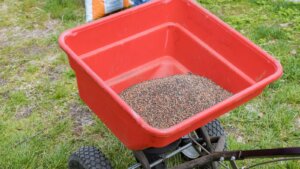Thinking of spreading grass seed on top of dirt and hoping for the best? You’re not alone—and the good news is, yes, it can work.
But just tossing it on the ground isn’t enough. For real results, grass seed needs a bit of prep, the right conditions, and some light maintenance.
In this practical guide, you’ll learn how to plant grass seed on top of soil the right way—without burying it deep, wasting seed, or waiting forever for growth.
Quick Seeding Tips That Work

Tossing grass seed on bare spots or the ground might seem easy, but without prep, it won’t grow well. Always loosen the topsoil first for proper seed-to-soil contact.
Lightly cover the seed with straw or 1/8–1/4 inch of fine soil. Too much cover blocks light; too little dries out.
Use 6–10 lbs per 1,000 sq ft for new lawns, and 3–5 lbs per 1,000 sq ft for patching. Don’t overdo it – too much seed leads to weak, overcrowded growth.
Preparing the Soil for Grass Seed
Whether you’re planting a new lawn, fixing bare patches, or overseeding an existing lawn, your first step is prepping the ground:
1. Clear and Loosen the Soil
Use a garden fork or rake to loosen the topsoil, especially if you’re working with clay soil. Aeration helps water and air reach the seed and encourages healthy growth.
2. Remove Debris and Level the Surface
Clear away weeds, sticks, and rocks. Then level the area to create a smooth seedbed.
3. Test and Improve the Soil
Check the pH (aim for 6.0–7.0) and amend the topsoil with compost, organic matter, or sand for better drainage and fertility.
Quick Seeding Tips That Work: A Checklist for Success
| Step | Why It Matters | How to Do It (Quick Tips) |
| 1. Prepare the Soil | Seeds need good contact with soil to germinate. | Loosen topsoil (1-2 inches), clear debris, level surface. |
| 2. Choose the Right Seed | Matching seed to climate ensures success. | Select grass type suited for your region (cool/warm season). |
| 3. Sow Evenly | Prevents patchy growth and wasted seed. | Use a spreader for uniform coverage. |
| 4. Lightly Cover (Optional but Best) | Protects seeds from birds, wind, and drying out. | Gently rake or top-dress with a thin layer of compost/soil. |
| 5. Water Consistently | Moisture is crucial for germination and establishment. | Keep soil consistently moist, but not waterlogged, until sprouts appear. |
| 6. Protect Your Seeds | Prevents disturbance and maximizes germination. | Limit foot traffic, consider light netting in windy areas. |
| 7. Be Patient | Grass takes time to establish. | Expect results over several weeks; avoid over-fertilizing too early. |
Choosing the Right Grass Seed for Your Lawn
Different grass types thrive in different weather conditions and soil types:
- Cool-season grasses (like fescue and bluegrass): Best for northern climates.
- Warm season grasses (like Bermuda and Zoysia): Ideal for southern regions.
Dealing with bare spots in your lawn? Use a blend that matches your existing lawn for a uniform look.
What Is the Downside of Ryegrass?
Ryegrass is fast-growing, but it lacks heat and drought resistance. It can crowd out slower-growing varieties and die back in hot climates, making it better for short-term fixes than long-term results.
| Grass Type | Best Climate | Key Characteristics | Ideal Use |
| Cool-season grasses (e.g., Fescue, Bluegrass) | Northern climates | Tolerates cold well, can struggle in intense heat. | Lawns in cooler regions, blends for year-round green. |
| Warm-season grasses (e.g., Bermuda, Zoysia) | Southern regions | Thrives in heat and humidity, may go dormant in cold. | Lawns in hotter regions, highly durable. |
| Ryegrass (Perennial/Annual) | Various (often cooler/temperate) | Fast-growing, lacks heat/drought resistance, can crowd others. | Quick repairs, temporary greening, overseeding dormant warm-season lawns. |
How to Plant Grass Seed on Top of Soil
Here’s the simple, proven method to make grass seed germinate on top of soil:
1. Spread the Seed
Use a broadcast spreader for larger areas, or hand-spread for small patches. Follow the label or use our grass seed calculator to figure out how much you need per square metre.
2. Lightly Rake or Roll It In
You want good seed-to-soil contact without burying the seed. A light pass with a rake or lawn roller does the trick.
3. Add a Thin Cover
Apply a light cover, like straw mulch or 1/8–1/4 inch of fine topsoil. This protects against birds, wind, and dry conditions while allowing light and air to reach the seed.
Watering and Maintenance
Grass seed needs to absorb moisture consistently for the first few weeks. Here’s how to handle watering:
- Keep the top inch of soil moist but not soggy.
- Water 1–2 times daily with a fine mist or gentle spray.
- Reduce watering once the new grass sprouts and begins to root.
Too little water = failed germination. Too much = seed washout or rot. Strike a balance.
Final Takeaway
Yes, you can sow grass seed right on top of soil—as long as the seed bed is prepped, the top soil is loose, and the seeds are slightly covered.
Add water, use starter fertilizer, and you’re on your way to a lawn that looks anything but labor-intensive.
Not sure which mix works best for shade or sun?
Terra Lawn Care helps gardeners across Pennsylvania grow a thick, healthy, established lawn—without the time-consuming guesswork.



